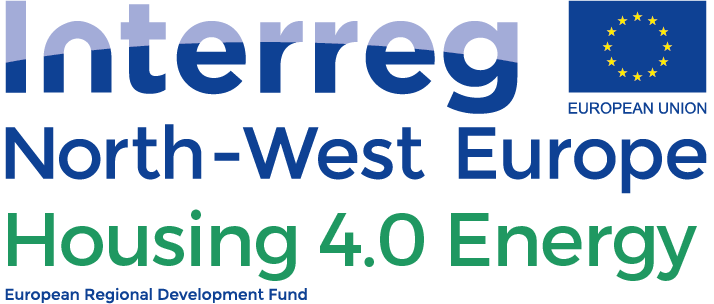One of the key long-term goals of the Housing 4.0E project is to ensure the replicability of its practices and principles beyond the project’s end date. Along with the key deliverables of the zero-carbon and low-carbon houses, built at the diverse testbed sites in Belgium, The Netherlands, Germany and Ireland, is an interactive, exploratory digital platform. The aim of the digital platform is to explore how we can use the world wide web to make it easier for developers, municipalities and communities to replicate manufactured housing solutions, like the ones being piloted by the Housing 4.0 Energy project.
The platform allows future developers and laypeople the abolity to design homes using the H4.0E principles (i.e., low carbon, affordable, small-scale), based on a menu of modules listed by regional manufacturers. It will allow users to instantaneously see the estimated impact of their design decisions on cost, carbon and energy use. The aim is probably obvious: to give users the information they need to make informed design choices, and factor-in the long term cost savings of up-front investment in good energy performance.
This section of the Guidebook will take a quick look at this digital platform to give insight into the considerations that went into its development, how we hope it will deliver positive long-term effects and some insight into the long-term plan of the platform itself and IP rights of partners.
The platform was designed with the user in mind. Because it is intended to be a platform that anyone can use regardless of their engineering/construction ability, it had to be intuitive to allow for quick build and design, but also in-depth enough to allow for more experienced users to create more bespoke designs. To achieve this, the platform will allow the user to use the designs already input from the H4.0E pilot testbeds and create a home that is similar to these but matching their own available space and land profile.
Transforming the design process
One of the most challenging transformations required to make this possible is not technical, but commercial. Today, most buildings are designed as one-off bespoke projects. That is to say, an architect produces a sketch design, then engineers check the validity of that design, and then a constructor bids to turn up and craft it.
The shift towards modern off-site manufacturing requires clients, manufacturers and installers to reverse this order: so a product manufacturer first designs, and engineers their solution as a modular ‘product’ (such as a building system or house type), then allows architects and clients to customise and configure buildings using those modules. In essence, to make the way we build homes much more like the way we make most other products in our lives, such as cars or kitchens. However, this transformation in the way we design and procure is challenging for developers, municipal authorities and construction businesses.
How we did it
In order to be useful beyond this project, the platform had to be able to support not just the modular building solutions being used by the H4.0E pilots, but most types of modular building products. To do this, the project has developed a ‘universal’ grid system that challenges manufacturers to break their product into ‘modules’. The design and size of these modules can vary enormously, but they all follow the same basic principles, and require product owners to bake-in key knowledge, rules and data to their modules.
The project has also focused on those aspects of the user journey that are universal, regardless of whether the user is an architect, a municipal client or a self-builder, taking into account factors such as what sequence of actions might feel logical to them or what vocabulary they might understand. New systems are expected to be added by the companies that invent them. To make the platform scalable and ‘localisable’, it puts power (and responsibility) into the hands of the product owner to maintain that data when something about the system changes, and to check that their product complies with all codes and regulations in the region where they make their product available.
An important aspect of digital platform design is considering who will host the platform and the Intellectual Property (IP) rights of the software, and the solutions on the platform. For H4.0E, Open Systems Lab (OSL) has taken on the designing and hosting of the platform. OSL is a non-profit R&D lab working on open digital innovation and is based in the UK. The entirety of the code of the platform is published under an open source license. OSL also intends to continue hosting and developing the platform after the project ends.
GDPR considerations must also be given to this platform. As it stands, the platform does not ask for personal data. However, should it need to in the future, this data will have to be stored in a GDPR compliant country to ensure the protection of the citizen’s data. Currently, the platform’s servers are located in the US and are stored by Digital Ocean and Airtable. A switch to AWS (in the UK and EU) is intended in the short-term, and in the long term, OSL intends to store the data in a zero-emissions server.
